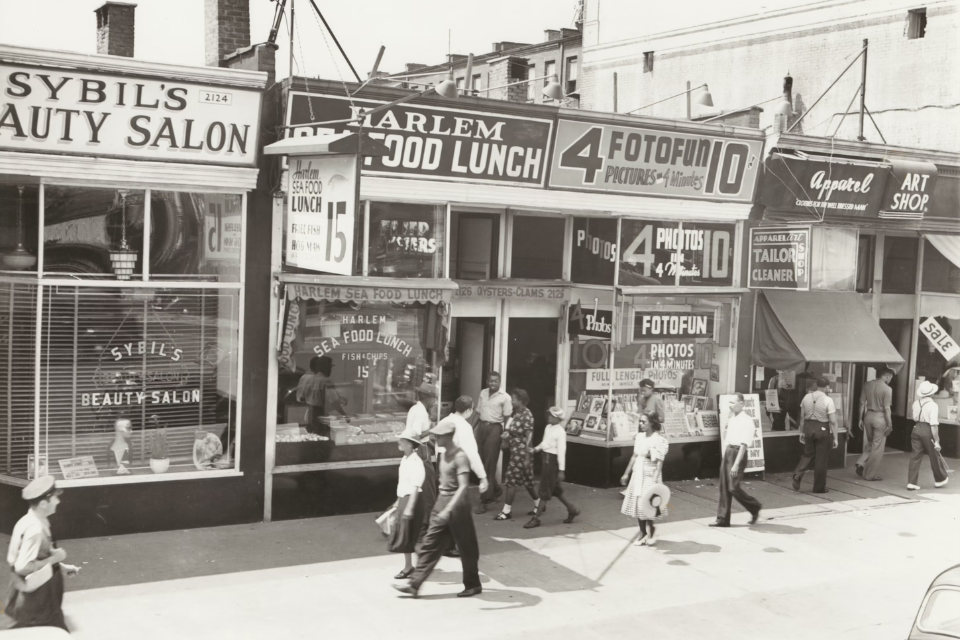Music of the Harlem Renaissance
April 25, 2022

View of Harlem storefronts, 1939. │Photo Credit: The New York Public Library via Unsplash
by Phil Radoff and Jack Curley
In January and February, a large group of BOLLI members attended a series of complimentary lectures on aspects of the Harlem Renaissance, that period in American History from roughly the early Twenties to the late Thirties or the end of World War II (depending on one’s point of view) that saw an explosion of creativity in the arts in Harlem’s African American community. The first lecture — on literary aspects of the Harlem Renaissance — was given by popular SGL Ben Railton, Professor of English Studies and Coordinator of American Studies at Fitchburg State University. His lecture focused on the works of three icons of the Harlem Renaissance: W.E.B. DuBois, Nella Larsen, and Langston Hughes.
DuBois was an influential figure, prolific writer, and founder of the NAACP whose book The Soul of Black Folk dealt nominally with black history but with broader implications for American history and was instrumental in bringing about the Harlem Renaissance. Nella Larsen wrote three widely read novels in the 1920s — Quicksand, Passing, and Sanctuary — that explored issues of race, sex, and relationships from women’s perspectives. Passing, in particular, pursues the very different marital relationships of three mixed-race women whose skin color is light enough to enable them to “pass” as white. The best known of the three writers was poet Langston Hughes, whose lengthy poem I, Too addresses the role of the Negro in America. The remaining lectures in the five-session series were delivered by Eric Elder, a Ph.D. candidate in Musicology at Brandeis. His presentations, which were enhanced by photographs, movie clips, and vintage recordings, afforded attendees a wide-ranging sample of the people and diverse music of the Harlem Renaissance and their precursors.
Harlem became a gathering place not only for southern blacks who traveled north during the Great Migration, in which approximately six million people moved from the American South to Northern, Midwestern, and Western states, but also for Caribbeans, whose indigenous music was an essential component in the development of the African American repertoire. Seminal figures of the time included Scott Joplin, Fletcher Henderson, Duke Ellington, Ethel Waters, Louis Armstrong, and the lesser-known James Reese Europe, whose 1912 Concert of Negro Music was the first Carnegie Hall concert performed by African Americans. Minstrel shows, jug bands, cabaret, ragtime, spirituals and blues were all part of the Harlem scene. Military bands organized in towns throughout the country became an unlikely but important influence, as participants were often provided with free musical training. One beneficiary was the young Louis Armstrong, a member of the New Orleans “Colored Waif ’s Home Band.” Racism, both subtle and overt, was, of course, in evidence. Sheet music, which at the time was widely distributed and highly profitable, frequently depicted African Americans in vulgar and objectionable ways. Songs of the era were often shaped to appeal to a white audience. As one example, Elder cited Hoagy Carmichael’s Old Man Harlem, which, when performed by Carmichael, portrays Harlem as a den of iniquity, while later performances by Eddie South and Ethel Waters paint a quite different picture.
Elder made frequent reference to the writings of African American educator and philosopher Alain Locke and his pursuit of “an ideal Harlem Renaissance aesthetic.” Deemed by Elder “a cultural constructionist,” Locke felt that the music of the Harlem Renaissance should aspire to an “evolutionary goal” and saw it as caught between the “folk form” and the training and tradition of a “higher European art form.” As for the audience, it’s safe to say that most came away from the lectures pleased that, while Locke pursued his philosophical musings, the gifted musicians of the Harlem Renaissance played on.
This article was originally posted in March 2018. Minor edits have been made to the original version.